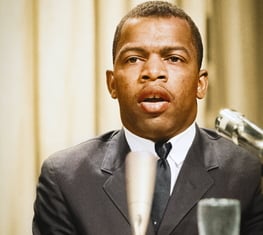This story was originally published by Columbus Dispatch.
Voting rights groups are concerned that thousands of voters could be erroneously purged from Ohio’s voter rolls after digging into a list Secretary of State Frank LaRose’s office compiled from 88 county boards of elections.
In a letter to LaRose, the League of Women Voters Ohio, All Voting Is Local, the NAACP Ohio State Conference and Campus Vote Project called on the first-year Republican secretary to “pause the state’s voter purge process and not move forward on September 6” as planned.
About 4,000 registrants on the list of the 235,000 voters who could be purged next month also are listed as active voters in the state’s voter database, said Mike Brickner, Ohio director for All Voting Is Local, at a press conference Thursday. Those groups are calling for a statewide audit of the purge list and for an immediate halt to the Sept. 6 deadline.
“The (League of Women Voters) is looking at all options from legal to ballot initiatives” to stop Ohio’s voter purge, said Jen Miller, the organization’s executive director. The U.S. Supreme Court ruled last summer that Ohio’s process was constitutional.
Brickner said All Voting Is Local on Wednesday discovered the 4,000 active registrants on the list of voters to be purged. The Secretary of State’s Office had not received a list from the group as of 1 p.m. Thursday.
The purge scheduled for September is the second of 2019. Earlier this year, about 265,000 voters were removed from the rolls, including 120 in Franklin County who had signed petitions, which is considered a voter activity that should prevent those registrations from being canceled. Acting on the next planned purge, the Franklin County Board of Elections mistakenly sent more than 1,100 last-chance notices in July to other voters who signed petitions.
Ohio’s 88 county boards of elections sent last chance notices to about 235,000 voters at the end of July, two weeks after submitting their list of registrants who could be purged from Ohio’s voter rolls to LaRose’s office. That was in response to a directive LaRose issued in June calling on the boards to clean up the state’s roster of registered voters, as required by state law.
LaRose has maintained that his office is following state law in canceling voter registrations.
Registrations can be removed if they are duplicates, the voter has died or moved to another state, and Ohio has a second “supplemental process” that allows those who have not voted for six years to be removed for inactivity. Ohio law directs the Secretary of State to cancel registrations for inactive voters four years after they receive a “confirmation notice,” which is triggered by two years of inactivity. Former Secretary of State Jon Husted, now lieutenant governor, sent those notices in June 2015.
This purge represented the first time, though, that the secretary of state had compiled a statewide list of voters who would receive a last-chance notice. LaRose shared what he calls the “Registration Reset List” with groups and individuals interested in reaching those who could be purged to encourage them to respond to the notice.
But some of those groups have found an online system intended to direct the voters to check if they are on the list to be cumbersome, Brickner said.
They also lack the resources to quickly contact 235,000 voters in the month between when LaRose’s office distributed the list and when the purge is scheduled to take place, he said, and they are concerned that discrepancies that appeared in counties, including Franklin, could have happened elsewhere.
“We will continue to work with organizations and churches across the state to locate Ohioans who want to stay active while also working with the General Assembly to improve the process we use for list maintenance in the future,” LaRose said in a prepared statement.
LaRose’s office also provided statements from five people, including two pastors, a Toledo City Councilwoman and the chief executive at Urban League of Greater Cleveland, praising his efforts.
The Ohio Republican Party praised LaRose’s effort to provide the list to organizations, including the state GOP, that asked for it.
“These groups that are complaining about this lack any understanding of how to properly register voters and are frankly not good at what they ‘do’. We have already gone through the list and are actively reaching out to these disengaged voters. Instead of complaining, these groups should actually get to work to encourage people to exercise their civic duty,” said Evan Machan, Ohio GOP spokesman, in an email.
The Registration Reset List includes names and voter identification numbers, but no contact information or the reason the voter is on the list, Miller said. Organizations that want to use the list have had to track down that information themselves, making it harder for them to quickly organize campaigns to contact those who could be purged, she said.
“We are concerned that this process is making our list less accurate,” she said.
The League of Women Voters first raised problems with the list and online system with LaRose’s office on Aug. 5, she said, but it has not received a response.
All Voting Is Local plans to send text messages to 40,000 voters for whom the group has used third-party databases to find mobile phone numbers. The groups also are planning to organize phone banks to reach potential voters.
Voters who receive a last-chance notice can avoid being purged by responding to the postcard they receive from the local board of elections, updating their registration at voteohio.gov or mailing in a new voter registration form. Miller said the last-chance notices are confusing, and the League of Women Voters is recommending individuals who are worried they could be purged to re-register.
“If this purge process is going to continue it needs a complete overhaul,” she said.
LaRose also announced on Thursday that his office is working with a nonprofit organization to send postcards with registration instructions to 168,395 people who are unregistered but eligible to vote in Ohio.
The Latest from the League
Justice Department Flip Flops on Voting Rights in Ohio Purge Case
By changing their position in the 2016 Ohio voter purge, the Justice Department is playing politics with our democracy and threatening the fundamental right to vote.
The League of Women Voters of Texas and other civil rights groups reached a settlement with Texas state officials today to end the discriminatory purging of the state’s voter rolls.
Today, the state of Kansas begins the process of purging tens of thousands of voters from a suspension list created for otherwise eligible voters who were unable to fulfill a restrictive proof-of-citizenship requirement.





